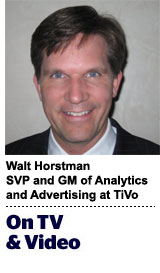 “On TV And Video” is a column exploring opportunities and challenges in advanced TV and video.
“On TV And Video” is a column exploring opportunities and challenges in advanced TV and video.
Today’s column is written by Walt Horstman, senior vice president and general manager of analytics and advertising at TiVo.
The Telecom Act of 1996 deregulated the telecommunications industry and inspired new companies to enter the market and compete with the major incumbents, including Bell Atlantic, SBC and the other Baby Bells.
As a management consultant in the sector, I experienced both the optimism of the new entrants and the savviness of the incumbents. In the end, the entrants made an important strategic misjudgment: They assumed the incumbents would stay their historic course and not evolve in the new deregulatory environment. Consequently, many of their high expectations abruptly ended with the telecom crash of 2001.
Similar assumptions are now being made about the television industry. Too often prognosticators have predicted the decline and ultimate end of TV. They have assumed that TV will only stay its historic course and not adapt to a rapidly changing technology- and consumer-focused landscape.
This particularly holds true for assumptions about TV advertising. Some predict that it will stay mired in old-school Nielsen metrics and won’t worry about measuring business results or adapt to changing consumption preferences, especially among younger consumers. However, these assumptions are quickly proving to be false.
We may one day look back and mark 2017 as the year that TV shifted its course and actively went on the offense. Nothing speaks more to TV’s new offensive position than its adoption of first-party data at scale – from both the buy and sell sides.
Marketers have longed to bring targeting accuracy to their campaign executions for TV, mirroring the advertising innovations of the digital players. Using first-party data, rather than inferred proxies, delivers on that accuracy. For TV to help drive marketers’ goals, several factors, years in the making, have come to fruition.
After closely guarding their set-top-box data for so long, for example, multiple MVPDs, representing millions of households, now allow their data to be ingested and aggregated into a common national pool. The data can be matched in a PII-protected environment with industry-leading identity keys.
Concurrently, over the years, brands have invested in CRM systems so they can now easily collect, standardize and use their own first-party data. Finally, the major mar tech players have made great strides in increasing the match rates across data sets. All of these advances have come together to enable brands to accurately and deterministically match their first-party data with TV set-top data and apply it to deliver more effective national TV advertising campaigns.
How these matched data sets are specifically applied to TV campaigns marks another proof point of TV’s new offense. Historically, these first-party matched data sets would have just been used for planning. The data would inform the ideal TV programs, networks or dayparts to reach the first-party audience. And while there’s been plenty of buzz about that development, once the ideal plan was handed to the buying team, after taking into account pricing negotiations and inventory availability, the executed buy often looked quite different from the original plan, defeating its initial purpose. Today, with advances in workflow automation and audience prediction algorithms, the first-party data is now used not just to plan, but to buy and execute the entirety of the TV campaign.
Brands are also closing the loop and using their matched first-party data to precisely measure their TV campaigns’ impact on business outcomes with a high degree of sophistication and specificity. Now they can determine the answer to questions like, “How effective was the TV campaign in driving a defined segment of customers to upgrade to the premium offering, and what is the ROI?” or, alternatively, “What is the ideal TV frequency to maximize effectiveness for defined business outcomes among different customer segments?” These levels of insight can now be proven with data rather than inferred by extrapolation.
Marketers have always respected the unique marketing power of TV advertising and its incumbent position in the media landscape. The stakeholders in TV advertising – marketers, agencies and inventory providers – prove that TV is not standing still, but adapting with alacrity to a new environment increasingly centered on data. As a result, these stakeholders are enjoying the shared benefit of measurable ROI from TV advertising, greater insights into the consumer’s relationship with marketing messages and a better understanding of TV inventory’s value and impact.
Follow TiVo (@TiVo) and AdExchanger (@adexchanger) on Twitter.
This post was syndicated from Ad Exchanger.

More Stories
Fintech’s On-Ramp To Retail Media; Does YouTube Count As CTV, Digital Or Both?
Publicis Groupe Asia Pacific announces four promotions
Inside Heineken’s 22-Year Partnership With Coachella, ‘Gen Z’s Super Bowl’